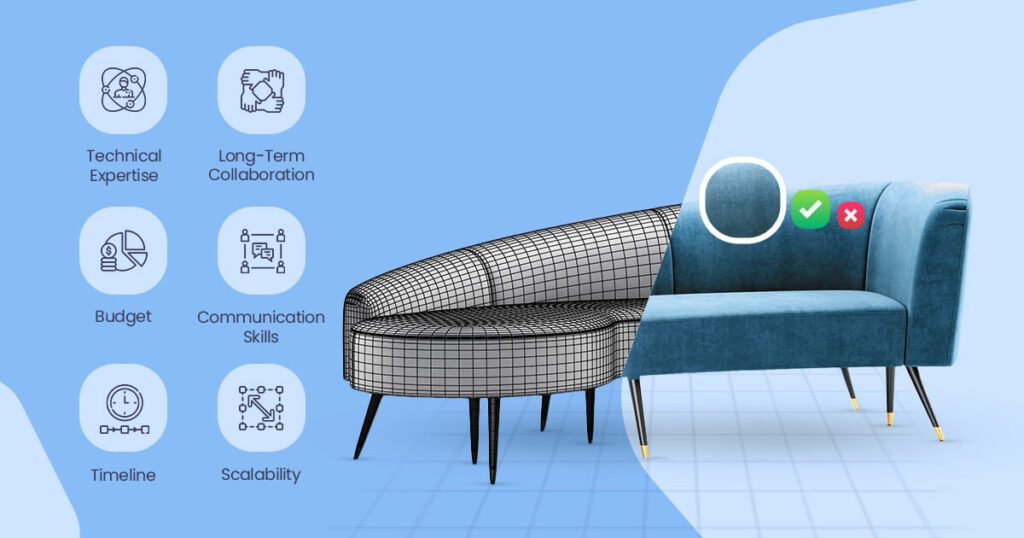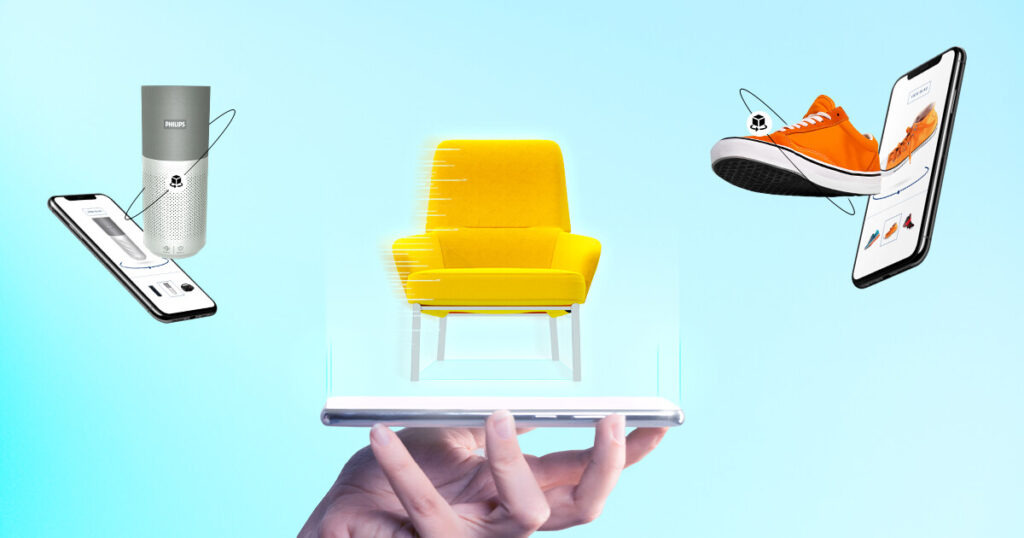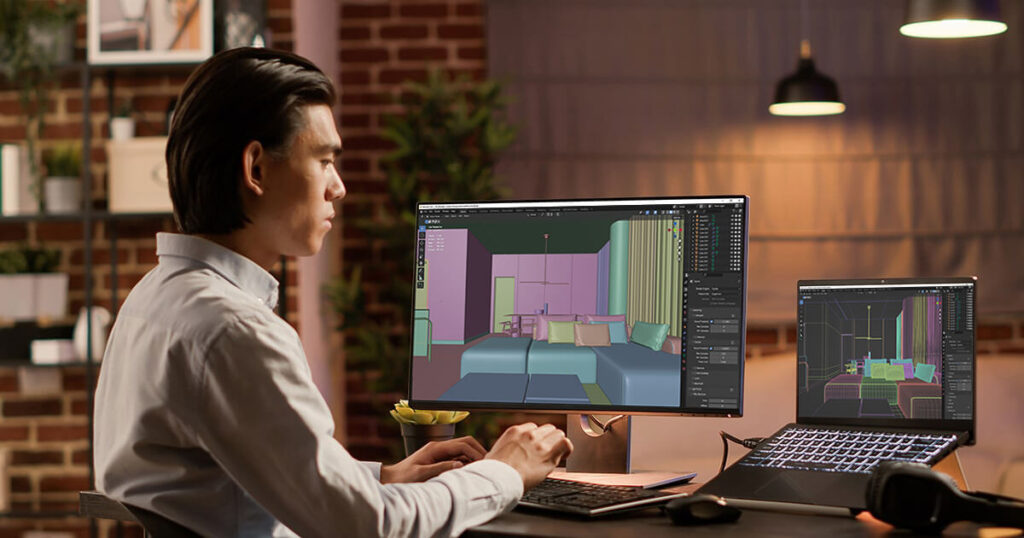Furniture 3D models are becoming a part of the furniture business. Furniture shopping is undergoing a digital revolution. Static and blurry furniture product photos have become old now. Today interactive furniture 3D models are transforming the shopping experience for the customer. These 3D models allow customers to see the furniture from all angles, zoom in on intricate details, and even rotate it to visualize how it would look in their own space.
It is undeniable that furniture sales are moving online. According to Traqline, almost half (49%) of all furniture purchases in 2022 were made online (Source: Traqline). Furniture brands need to come up with creative ideas to draw customers in and establish credibility on the internet given the rise in e-commerce. 3D models of interactive furniture can help with that. Customers adore them, and furniture brands who include them in their online strategy stand to gain a great deal.
In this blog, we’ll discuss what is furniture 3D models, why shoppers love interactive furniture 3D models, and how furniture brands can benefit from it.
What are Interactive Furniture 3D Models?
The process of virtually creating furniture models with the proper shape, texture, material, and finish all in virtually is known as 3D furniture modeling. Furniture 3D models are digital representations of the furniture that enable exploration and interaction, rather than merely being static images. These models have a number of important characteristics and are created with specialist software. 3D models have:
- Three-dimensionality: Unlike flat photos, 3D models help to see furniture from all angles, just like in a physical store. It’s easy to rotate it 360 degrees, zoom in for intricate details, and get a true sense of scale and depth.
- Interactivity: Interactive 3D models allow us to manipulate them in various ways. Spin them around, zoom in on specific details like fabric textures, or even see how they might look in different lighting conditions. Some models even allow for customization, letting you virtually test different colors or upholstery options.
- Photorealism: Furniture models made with modern 3D modeling techniques can be incredibly realistic. High-resolution textures, lighting effects, and even shadows are frequently included in these models to produce a realistic feel.
store shopping and online shopping by combining these features. They boost consumer confidence and satisfaction by giving them the opportunity to get a far better feel for the furniture before making a purchase.
3 Reasons Why Shoppers Love Interactive Furniture 3D Models
The traditional way of browsing furniture online with flat and static images is quickly becoming a thing of the past. Today’s shoppers are demanding a more immersive and interactive experience. These 3D innovative models are revolutionizing online furniture shopping by offering a delightful and practical experience for customers. Here are the top 3 reasons why shoppers absolutely love interactive furniture 3D models:
Reason 1: Better Visualization and Improved Decision-Making
Traditional flat white background photos are old now. Trying to imagine how the couch product would look in the living room. Interactive furniture 3D models offer a whole new level of visualization, empowering shoppers to make informed decisions with confidence. Here’s how:
- See Furniture from Every Angle: 3D models allow shoppers to rotate furniture 360 degrees, which is difficult in static photos. This 3D model helps to see the product from all sides, just like in the physical store.
- Experience Furniture in Different Settings: Interactive 3D models aren’t confined to a white background. All 3D models are easy to place in virtual room settings. This helps visualize how the scale and style of the piece will work with the existing décor and layout. No more guesswork about whether that new armchair will overpower in living space.
- Get a True Sense of Scale and Fit: When it comes to size, traditional photos can be quite misleading. With 3D models, it enlarges the image to see how big the furniture will be and to make sure it won’t take up too much space. This is particularly useful for larger pieces, such as entertainment centers or dining tables.
Furniture 3D models make online furniture shopping less uncertain and stressful by providing this level of detail and interaction. Customers will feel more secure about their purchases, which will reduce returns and improve their overall satisfaction.
Reason 2: Increased Engagement and Improve Shopping Experience
Online furniture shopping done the old-fashioned way can feel cold and impersonal. Images that are static fail to better viewers’ interest or establish a personal connection with the brand. Conversely, interactive 3D models change the encounter and give customers a more interesting and immersive experience:
- Interactive Exploration: 3D models allow shoppers to actively interact with the furniture. Customers can rotate it, zoom in on details like textures and finishes, and even explore different color options (in some models). This interaction creates a more playful and engaging experience than just passive browsing, akin to physically perusing furniture in a store.
- Deeper Product Connection: When furniture is interactive in a virtual setting, customers can connect with it more easily. When people can visualize themselves using and arranging the furniture in their own homes, they will be better able to appreciate its beauty and practicality. They consequently become more emotionally committed to the choice to purchase.
- Increased Browsing Time: Because 3D models are interactive, customers are more likely to stay interested in them. They are more likely to take their time browsing through various furniture options, trying out various configurations, and customizing pieces to fit their preferences. This increases the browsing session and enhances the buying encounter.
Furniture 3D models provide an immersive and interactive online experience that goes beyond product display. The 3D visualizations of an environment captivate customers, encourage deeper connections, and eventually result in more satisfying and well-informed purchases.
Reason 3: Improved Confidence and Trust in Online Furniture Purchases
The inability to physically interact with the furniture is one of the main drawbacks of purchasing furniture online. Customers can’t sit on a couch and feel its comfort or examine the fabric’s texture up close. This could cause one to hesitate and be reluctant to make a significant purchase. Interactive 3D furniture models, on the other hand, considerably close this gap and promote confidence when making furniture purchases online:
- Improve Realism: 3D modeling techniques create incredibly realistic representations of furniture products. For a more realistic feel, these 3D models have high-resolution textures, lighting effects, and even shadows. So, the customers can get a much better sense of the furniture’s materials, finishes, and overall quality compared to a flat photo.
- Accurate Size Representation: The size of static images can often be deceiving. Customers can zoom in for in-depth views and a realistic sense of the furniture’s dimensions with 3D models. This lessens the chance of disappointment.
- Reduced Risk Perception: Before making a purchase, customers can address any concerns by interacting with furniture in a virtual environment. They can determine whether an item is comfortably sized for the area they have designed, make sure it doesn’t obstruct doors or walkways, and evaluate its general size and applicability for their purposes. 3D models considerably lower the perceived risk connected with online furniture purchases by reducing these uncertainties.
Furniture 3D models give customers a realistic and interactive experience that gives them the confidence to make well-informed decisions. Their online shopping experience will be more fulfilling because they can be sure the furniture will live up to their expectations.
How Furniture Brands Can Benefit from Interactive Furniture 3D Models
The benefits of interactive furniture 3D models extend far beyond just happy shoppers. Furniture brands can unlock a wealth of advantages by incorporating these innovative models into their online strategy:
- Boost Sales & Conversions: Interactive 3D models lead to increased purchases, increased engagement, and potentially lower returns. All contributing to a significant sales boost.
- Customer Experience & Brand Image: Offering interactive shopping experiences such as AR/VR or 3D product configuration, can establish credibility and positive word-of-mouth while showcasing creativity and commitment to customer satisfaction.
- Streamline Design & Marketing: Help to reduce photography costs while expanding your virtual product range with variations for marketing purposes, streamlining design and marketing processes.
Conclusion
You can get a lot of benefits by using 3D models in your online strategy, such as increased sales and conversions and customer-focused experiences that encourage brand loyalty. Don’t get left behind!
Wanted to take your furniture brand to the next level? Get in touch with us right now to find out more about how our 3D modeling services for furniture can help you develop an engaging online presence and change the way your clients purchase furniture.






